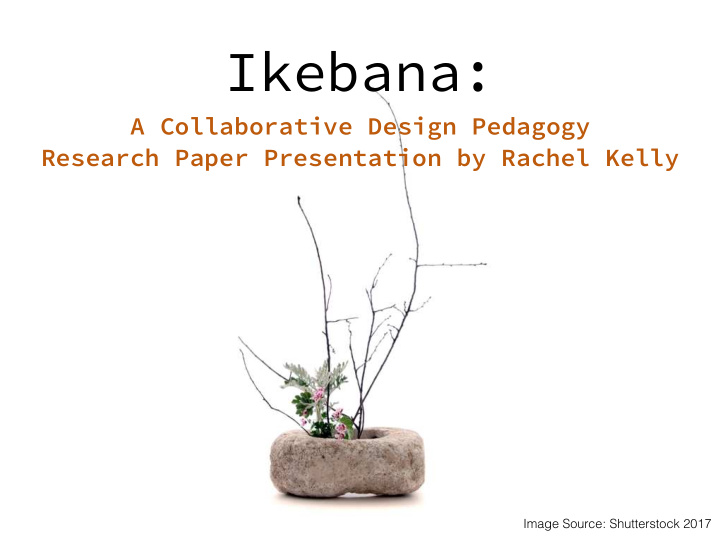



Ikebana: A Collaborative Design Pedagogy Research Paper Presentation by Rachel Kelly Image Source: Shutterstock 2017
Introduction This paper evaluates current collaborative Teaching and Learning within Art and Design Higher Education in the UK. The research for this work considers evidence suggesting that student led collaborative projects can develop new teaching methods and engages students as co-developers of their learning experience. (HEA, 2014)
The Teaching Context: L5 Undergraduate Collaborative Art & Design Interdisciplinary Teaching Units. “I don’t like it, (working in a group) but I guess it is good for us to do. We’ll have to get used to it’ L5 Fashion student” (Goodman 2016). Image Source: Rachel Kelly 2016
Image Source: http://www.brave-new-alps.com
Theoretical Perspective “The words 'collaborative learning' describe a situation in which particular forms of interaction among people are expected to occur, which would trigger learning mechanisms, but there is no guarantee that the expected interactions will actually occur. Hence, a general concern is to develop ways to increase the probability that some types of interaction occur”. (Dillenbourg,1999:5)
Sarah Mann’s 2001 paper Alternative Perspectives on the Student Experience: alienation and engagement explores how alienation has become a defining feature of undergraduate student experience. (Mann 2001:7)
Image Source: Rachel Kelly 2016 Collaborative ‘Paper Reading’ session… “Having to explain to non- specialists what you do is the most difficult and helpful challenge to face in any project” (Knott, Hunter and Elzenbaumer 2010:67).
Image Source: Rachel Kelly 2017 Creative thinking and learning within collaborative activity takes place during action and is pre-reflective , as Heidegger in his 1927 work Being and Time considers “ready-at-hand” and “present-at-hand”, knowing to be (Coghlan & Brydon-Miller 2014:5).
Methodology 1.Subject- Shin, Object- Soe and base- Utsuwa (Ohara 2015) 2.Use of organic, ambiguous or disconnected materials to create coherent outcomes. 3.The manner of “ad-hoc or bricoleur qualities” (Adamson 2007:89) working in congruity with the circumstances and materials to hand, rather than creating something designed. 4.Vygotskian More Knowledgeable Other(1978) role where the tutor becomes a facilitator and participant. 5.Space and object as a metaphor for collaborative practice. Students visualise their projects as models to support reflection for assessment. Image Source: Shutterstock 2017
Image Source: Rachel Kelly 2016
“the idea of using branches was a bit weird at first… but when we used them to show how our group had been working and to represent how we feel it really was useful to see how everyone was feeling in the group. Because otherwise I think we would have carried on and not said anything” Anonymous L5 Design Student Reflection. (Goodman 2016). Image Source: Rachel Kelly 2016
Literature Review Image Left: Department 21 at RCA(2009 -2010) Image Below: Elizabeth Kealy-Morris’s Collaborative Bookbinding Workshops at The University of Chester in 2015
Image Source: Rachel Kelly 2017 Hierarchical structures impact upon the teaching and learning context which supports collaborative learning. In removing such structures and when students and staff work side by side as equals outside of the formal University teaching context , a shared learning space is created encompassing the Lebensweld ( Edmund Husserl 1859-1938)
Image Source: Rachel Kelly 2017 “Shared understanding can be viewed as an effect, if the goal is really that a group builds the common grounds necessary to perform well together in the future”.(Dillenbourg, 1999:12).
“It is saddening to consider that students have such difficulty with collaboration, the myth of the single genius is still too strong and education is generally a very individualising experience” state Bianca Elzenbaumer & Fabio Franz 2017. Image Source: http://www.brave-new-alps.com
Conclusion To develop HE Art and Design collaborative pedagogy requires: • well supported faculty and department facilitation; • access to appropriate and stimulating shared learning contexts; • structured delivery of teaching and learning specific to the development of collaborative practice including the use of collaborative learning tools. Image Source: Shutterstock 2017
References Adamson, G (2007) Thinking Through Craft. London: Bloomsbury Dillenbourg, P. (1999). What do you mean by collaborative learning. Collaborative-learning: Cognitive and computational approaches, 1, 1-15. Oxford: Elsevier. Department 21 (2010) Edited by Polly Hunter, Bianca Elzenbaumer and Fabio Franz www.department21.net / ISBN 1374-1283-23484 DEPARTMENT 21 London. Gauntlett D (2014) Micro LEGO Serious Play: How small can a useful tool for thinking be? http://davidgauntlett.com/tools-for-thinking/micro-lego-serious-play-how-small-can-a-useful- tool-for-thinking-be/ Goodman,A. (2016) Unit X Evaluation Report. Manchester School of Art Given, L (2008) The SAGE Encyclopedia of Qualitative Research Methods accessed: http:// dx.doi.org.ezproxy.mmu.ac.uk/10.4135/9781412963909.n317 Healey, M; Flint, A; Harrington, K. (2014) Engagement through partnership: students as partners in learning and teaching in higher education. York: The Higher Education Academy. Kealey-Morris (2015) The bookbinding workshop: Making as collaborative pedagogic practice. Art, Design & Communication in Higher Education 14:2, pp.119-129, doi:10.1386/adch.14.2.119_ Mann, S J (2001) Alternative Perspectives on the Student Experience:alienation and engagement. Studies in Higher Education 26:1 pp.7-19, doi:10.1080/0375070020030689 Ohara, H (2015). Ikebana for Everybody: Ohara School. Tokyo: Ohara Centre of Tokyo. Vgotsky, L.S; edited by Michael Cole, Vera John-Steiner, Sylvia Scribner, Ellen Souberman (1978) Mind in society: The development of higher psychological processes. Cambridge, Mass; London Harvard University Press.
Contact: rachel.kelly@mmu.ac.uk Acknowledgements: The author would like to thank the project participants, students from Manchester School of Art and The Faculty of Science and Engineering at Manchester Metropolitan University who kindly offered their models, reflections and insights which have enriched this research and paper. The author would also like to thank Elizabeth Kealy-Morris, Matthew Holman, Robert R McKay, Bianca Elzenbaumer and Fabio Franz specifically for their support in the development of this paper. The author thanks Dr Sam Illingworth and Annie Carpenter in welcoming Ikebana into their Testing the Field research project and Middlewood Trust, Lancashire who supported the facilitation of the residency and workshops within their lansdcape. This paper was prepared as part of a Scholarship of Teaching and Learning Project for the Centre of Learning and Teaching Excellence at Manchester Metropolitan University and thanks is given to Charles Neame and the team at MMU CELT, Joe McCullagh and Jane McKeating Associate Heads of Design at Manchester School of Art who have supported this research, making the publication of this paper possible.
Recommend
More recommend